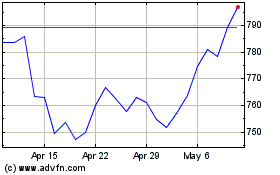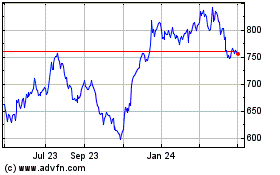By Liz Hoffman
Morgan Stanley said it is buying fund manager Eaton Vance Corp.
for $7 billion, continuing the Wall Street firm's shift toward
safer businesses like money management.
The deal comes just days after Morgan Stanley completed its $11
billion takeover of E*Trade Financial Corp., and is another leg in
a decadelong turnaround project for Chief Executive James Gorman,
who has closed risky trading operations and doubled down on wealth
and asset management.
Its pivot mirrors a broader shift in power and profits on Wall
Street. The trading profits of the 2000s are long gone, sapped by
new regulations and shifting investor preferences. Asset
management, which produces steady fees and requires little capital
to run, has become a priority for banks including Goldman Sachs
Group Inc. and JPMorgan Chase & Co.
Morgan Stanley is a midsize player in that space, too small to
reap the cost savings of being a giant like BlackRock Inc. but too
big to credibly style itself a boutique. By acquiring Eaton Vance,
it will join the club of $1 trillion money managers and bulk up in
specific products where it is weaker, such as municipal bonds and
sustainable investing.
Morgan Stanley is paying $56.50 per Eaton Vance share in cash
and stock, roughly 40% above the fund manager's closing price
Wednesday. Mr. Gorman has been seen as overpaying before, offering
similarly large premiums to acquire E*Trade and, before that, a
company called Solium that manages employee stock plans.
"People who hang around trying to buy great companies cheaply
never get anything done," Mr. Gorman said Thursday. Morgan Stanley
shares opened lower but were up slightly in morning trading. Eaton
Vance's shares jumped nearly 50%, baking in a $4.25-a-share special
dividend that was announced as part of the takeover.
In Eaton Vance, Morgan Stanley gets another midsize player in an
increasingly tough business. Investors once gravitated toward the
kind of funds that the Boston-based firm is known for, where
well-paid stock-and-bond pickers dig into financial records in
hopes of outperforming the market.
But in recent years, investors have shifted toward passive funds
run by giants like Vanguard Group and BlackRock, which mirror the
market and charge tiny fees. The business has become a game of
scale, prompting a wave of mergers meant to trim costs and improve
margins. Janus Capital Group Inc. and Henderson Group PLC merged in
2017, Invesco Ltd. later bought OppenheimerFunds; Janus Henderson
and Invesco are now under pressure from an activist hedge fund to
merge themselves.
Morgan Stanley's asset-management arm is the smallest of the
firm's four businesses, contributing less than 10% of its revenue
last year. But Mr. Gorman has long had a soft spot for it because
it has higher returns, requires little capital to run and rarely
screws up.
Morgan Stanley once owned an in-house fund business, Van Kampen
Investments, but sold it to Invesco in 2009. At the time, Morgan
Stanley needed to raise cash to recover from the financial crisis,
and the practice of selling its funds to its captive retail clients
had raised concerns about conflicts of interest.
Since then, the industry has moved toward integrated financial
superstores, similar to grocery stores selling their own
private-label goods alongside big brands.
"Marty, if you're listening, I wish we'd never sold," Mr. Gorman
said on a conference call with analysts, a shout-out to Marty
Flanagan, Invesco's CEO. "Things evolve."
Morgan Stanley will have to navigate those conflicts again,
ensuring that its 15,000 financial advisers don't improperly steer
retail clients toward in-house funds over those run by rivals.
(JPMorgan Chase paid a $300 million regulatory fine in 2015 for
doing so.) And its investment bankers must be cautious about giving
internal funds preferential access to sought-after deals, like
private fundraisings for Silicon Valley startups.
Morgan Stanley has been in the asset management business since
the 1940s, when it carved out a niche offering U.S. investors
exposure to foreign stocks. By 1999, it was among the largest asset
managers in the world with $425 billion. But years of neglect and
the 2009 sale of Van Kampen dropped it outside the top 40.
Mr. Gorman in 2015 tapped Dan Simkowitz, a boyish-looking
capital-markets banker who advised the U.S. Treasury during the
financial crisis, to improve the business. He has been cleaning up
legacy messes, including writing down portfolios of old hedge-fund
and private-equity stakes, and scouting for acquisitions. The firm
pursued a fixed-income specialty shop, Logan Circle, in 2017,
according to people familiar with the matter, but lost out to
MetLife Inc. In 2018, it bought a small real-estate firm, Mesa
West, for about $200 million.
Eaton Vance, which traces its roots to the 1920s, brings about
$500 billion in assets. The combined new money manager would have
about $1.2 trillion in assets and $5 billion in annual revenue.
Morgan Stanley already is the largest distributor of Eaton Vance
funds, through its retail wealth-management arm, Mr. Gorman said.
Eaton Vance's funds are mostly sold in the U.S., while Morgan
Stanley does a bulk of its sales abroad. "It was sort of obvious,"
Mr. Gorman said in an interview. "If we didn't do this, someone
else would have."
He said Eaton Vance's CEO, Tom Fraust, approached him a few
months ago and found a receptive buyer, but that the bank needed to
complete its takeover of E*Trade first, which it did last week.
As with most things these days, the deal was negotiated over
Zoom. It was formally signed around 4 a.m. Thursday. "We've seen a
lot of each other's faces close-up," Mr. Gorman said.
The deal is expected to be completed in the second quarter of
2021.
Dawn Lim contributed to this article.
Write to Liz Hoffman at liz.hoffman@wsj.com
(END) Dow Jones Newswires
October 08, 2020 12:42 ET (16:42 GMT)
Copyright (c) 2020 Dow Jones & Company, Inc.
BlackRock (NYSE:BLK)
Historical Stock Chart
From Mar 2024 to Apr 2024

BlackRock (NYSE:BLK)
Historical Stock Chart
From Apr 2023 to Apr 2024
